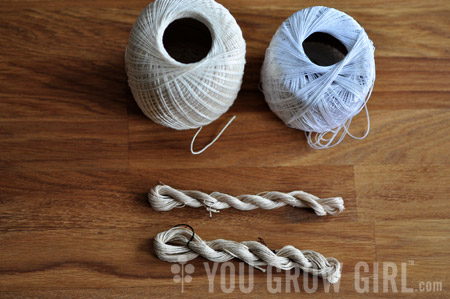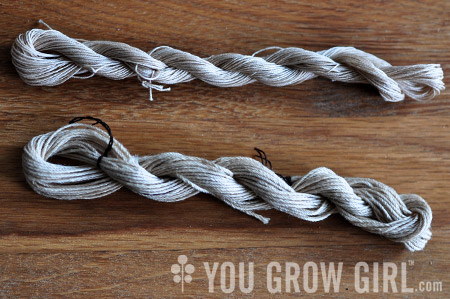
Last summer I resolved to try and make further use of the plants that I grow by employing them as natural textile dyes. When their season was through, I did a few experiments, dying various fabric scraps with the burgundy leaves and immature blooms of the large false roselle plants I had grown that year. Unfortunately, time quickly slipped through my fingers and the other plans I had in mind did not come to fruition.
This winter I have made a dramatic shift back to embroidery and my brain is consumed with thread. Recently, in preparation for the growing season, I have returned to experimentation, but this time I am dyeing threads rather than fabric.
One of the things I enjoy most about embroidery is its versatility. While, there are some rules, I see no reason why they can’t be broken. The material options available are nearly limitless. I’ve stitched into fancy linens, but I find that I prefer using scraps torn from old clothing and sheets. I’ve purchased floss new at craft and textile stores, but find that I most enjoy using vintage and second-hand threads that have been thrifted or purchased online. I’ve even used balls of cotton twine purchased at the corner store. Everything and anything will do and I am finding that I can find interesting materials in unexpected places.
Since balls of white, cotton crochet thread seems to be the easiest to find in thrift stores, I thought I would start buying those up cheaply and dyeing the thread in small batches using plant materials from my garden and food scraps that I happen to have on hand. These hand-dyed threads are not as brightly coloured as store-bought, but they have a certain charm and I like that garden and food scraps are seeing one more use before they head to the compost bin.

The threads shown above were boiled in used coffee grounds. The ball on the left is a thin, white mercerized cotton and the other is a thicker natural-toned thread. I don’t know their exact nature as they were purchased at a thrift store and did not come with a package. In the end the white cotton took the colour just as strongly as the natural, which was a good result for me as I was happy with the natural as-is, but plan to dye most of the bright white. Coffee grounds or used tea bags/scraps are easy to start with as they easily stain without any pretreatment. There is no right or wrong way to do this.
How To: All I did was soak the threads for an hour in water to prepare them to accept the colour. I then added 1 part used coffee grounds to 2 parts water and simmered it in a stainless steel pot along with the thread for about 30 minutes. I then turned off the heat and let them soak for a further 24 hours. The next morning I rinsed the threads thoroughly in lukewarm water and hung to dry.
Natural dyes take best when the fabric or threads have been pre-treated with a mordant. A mordant is a fixative that allows the dye to bind with the fabric or thread more readily. I haven’t been using mordants so far and haven’t been in a rush to bother. Next, I intend to experiment with all of the herbs that I dried last fall so that I can see what sort of colours they will make, giving me a better idea of what I may want to grow in larger batches this year.
I’ll write more posts later in the season as I go.
In the meantime, I recently purchased two books that can help you get started. Harvesting Color: How to Find Plants and Make Natural Dyes by Rebecca Burgess is full of useful information and technique; however, I found that the plant focus is geared more closely to natives of the West Coast and South West.
I haven’t had a chance yet to really sink into The Handbook of Natural Plant Dyes by Sasha Duerr, but as a general observation I’ve found that the plants covered are more suited to my region.
Do you use your garden (or foraged) plants to dye fibres for crafting and art making?
UPDATE: I’ve done a lot more experimentation since posting and have found that I don’t need to simmer on the stove. That may change depending on the plant (and the fibre), but I found that when I tried coffee again by simply brewing it in a small jar like a tea, the cotton thread dyed to the same intensity as it did when simmering. I’ve since tried a number of plant bits and scraps this way to the same end. You can see an updated photo with some new additions here.
I never have but my grandmother dyed eggs using beet juice. She and my mom also use henna to this day.
Have you seen this Ravlery Project? http://www.ravelry.com/patterns/library/west-desert-hood
I so, so want to do this!!
I haven’t but I really, really love it!
Beeeeeets! Imagine the vibrant colors you can get from a red/orange/yellow beet?! Ohhh it would look just grand!
@ previous comment on the Euphorbia post: Yes! I totally agree… as an artist I like to just be able to do my own thing… and I’ll promptly pick up stitching/embroidery as soon as I finish my first scarf! I can’t wait. I want to embellish all sorts of awesome things for my house. My walls are begging for some textile decoration!
Now Gayla, do you have any reccomendations on starting up on how to embroider/stitch? I would normally just buy a how-to book but the knitting one I found to be… confusing. So I ended up looking online instead. Is embroidery/stitching easier by book or by study?
[sorry to ask so many questions! I’m just excited that you’re doing posts about this! :D]
For everything concerning embroidery, the go-to website is:
http://www.needlenthread.com/
You’ll find how-to videos, book reviews, and much much more.
I think a combo of all works best. Once you learn the basics you really just need stitch bibles that reference various stitches. And you can make your own samplers to learn new stitches and then keep for future reference. I have a bunch of old books that I have bought at thrift stores that I use as bibles. However, I do find that I need a few to cross reference because they aren’t always very clear in their instruction.
Joey – Wowowow! Thank you! What a great resource that site is… I’m bookmarking it for future study!
Gayla – that’s actually a great tip. I would never think to go peruse some older publishings… some of the more modern books are just filled with ‘pretty’ projects. I don’t want cute bubbly cartoon elephants and ribbons. I want botanically accurate flowers and intricate script. :D
What wonderful ideas. I have a small bundle of very old white threads from my Grandmother and will try the coffee grounds technique on them. Thank all of you for your great lessons. PS I just saw a robin, here in the Mid-Atlantic.
Dyeing with plants is great fun. There are many very easy mordants you can use aound the house such as vinegar and even washing (laundry) powder, you don’t need much. If you are only dyeing threads keep the amount of water low and keep the temperature low no need to boil things furiously. Simmering is a better way to go. Solar dyeing is also a very effective way to get colour into fibre and is very eco friendly.
The one thing you will learn is that the colour of the plant isn’t necessarily how it will turn out! Beetroots are very disappointing in that regard. One of the best and easiest natural dyes is the humble onion skin.
Anyway enjoy your dyeing. PS Indigo, Madder&Marigold is also a great dye book.
I just found your comment as I came back here to update on some further experimentation and my observations are in line with what you are saying here. I did up a few small batches by simply making a tea-like brew in small mason jars and that worked just as effectively so I will do it by this method from now on unless the plant or fibre calls for something different. I think my initial problem was I was following how I’ve done it with fabric, which is in much greater quantities. I soon realized that I didn’t need to haul out the big dyeing pots to do up small thread skeins.
This is quickly becoming addictive.
Love natural dyeing! I grow a few dye plants in my near Calgary garden. My favorites are Japanese Indigo (I can send you some seed if you want), Woad, Dyers’ Coreposis, Madder, Rudbeckia, Goldenrod, Tansy, and various herbs/trees/shrubs. Also foraged things – oak leaves, walnut husks, weeds, and kitchen scraps – onions skins, tea bags, avocado skins. I mostly dye yarn, t-shirts, thrifted clothing, etc. A couple of my favorite dye books are A Dyer’s Garden by Rite Buchanan, Eco Colour by India Flint, and Natural Dyes by Dominique Cardon. The Burgess and Duerr books are just OK in my opinion – pretty and crafty, and they do focus on a sustainable approach, so worth having. Also check out Maiwa Supply – lots of online info/instructions.
Cheers,
Jake
Thanks for commenting! I had never tried avocado skins and did so over the weekend.. I was really surprised by the colour. I have tried onion skins, tumeric (both powder and fresh root), and pomegranate before with fabric, but did so again with thread. I was surprised by pomegranate skin. I love the colour of Indigo but don’t think I have the room for the plant. A dye store in Toronto sells it but I’d prefer to get the plant from a reliable, organic source. I look forward to trying coreopsis this year as I have it in my garden. I’ve tried smashing borage and other plants into fabric but with marginal success. This summer I’d like to experiment with this again. So many experiments!
Nice. I can’t grow true indigo here, but japanese indigo (Polygonum Tinctorium) grows well in pots on my deck. It has the same cultural requirements as basil, and actually looks alot like basil. It’s very cool to be able to produce rich blues (japanese indigo/woad), and reds (from madder) here from my garden. If you soak avocado skins in water with a bit of ammonia for a few weeks you can achieve deep brick shades. The pits also produce colour. Coreopsis produces a clear orange dye, very nice. I’ve been experimenting with soybean mordant – combined with tannin its supposed to work well on cotton. I also use alum and a bit of iron, not interested in metals like tin, copper and chrome.
If you ever run across plants or seed for dyers’ alkanet i would be interested in a source.
I would love to see more of your ongoing projects/experiments.